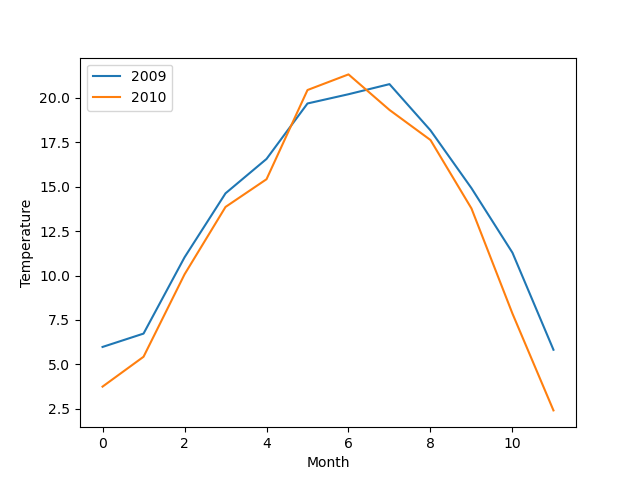Multiple line plots in Matplotlib
Categories: matplotlib numpy

In this section, we will learn how to show more than one data set on the same line plot.
We will use the monthly temperature data for both 2009 and 2010 to create line plot with both data sets.
Line plot with two data sets
Here is a line plot showing the temperatures for 2009 and 2010:

And here is the code to create it:
import matplotlib.pyplot as plt
import csv
with open("2009-temp-monthly.csv") as csv_file:
csv_reader = csv.reader(csv_file, quoting=csv.QUOTE_NONNUMERIC)
temperature_2009 = [x[0] for x in csv_reader]
with open("2010-temp-monthly.csv") as csv_file:
csv_reader = csv.reader(csv_file, quoting=csv.QUOTE_NONNUMERIC)
temperature_2010 = [x[0] for x in csv_reader]
months = range(12)
plt.xlabel("Month")
plt.ylabel("Temperature")
plt.plot(months, temperature_2009, label="2009")
plt.plot(months, temperature_2010, label="2010")
plt.legend(loc="upper left")
plt.show()
The code is here on github, in the file 2year-lineplot-monthly-temperatures.py.
This is similar to the line plots we have seen before, with a couple of differences.
Firstly, we read two sets of data:
- 2009-temp-monthly.csv is read into the list
temperature_2009. - 2010-temp-monthly.csv is read into the list
temperature_2010.
Secondly, we call plt.plot twice, to create the two line plots:
plt.plot(months, temperature_2009, label="2009")
plt.plot(months, temperature_2010, label="2009")
Matplotlib automatically gives the second plot a different colour.
Each plot is given a label. This is used to display the legend in the top left corner of the plot, indicating that the blue curve represents 2009, and the orange curve represents 2010.
The other difference is that we are dealing with monthly data, rather than daily data, so there are only 12 data values in each series. This means that we only need 12 x-values, one for each moth, obtained using:
months = range(12)
See also
Join the PythonInformer Newsletter
Sign up using this form to receive an email when new content is added:
Popular tags
2d arrays abstract data type alignment and angle animation arc array arrays bar chart bar style behavioural pattern bezier curve built-in function callable object chain circle classes clipping close closure cmyk colour combinations comparison operator comprehension context context manager conversion count creational pattern data science data types decorator design pattern device space dictionary drawing duck typing efficiency ellipse else encryption enumerate fill filter font font style for loop formula function function composition function plot functools game development generativepy tutorial generator geometry gif global variable gradient greyscale higher order function hsl html image image processing imagesurface immutable object in operator index inner function input installing iter iterable iterator itertools join l system lambda function latex len lerp line line plot line style linear gradient linspace list list comprehension logical operator lru_cache magic method mandelbrot mandelbrot set map marker style matplotlib monad mutability named parameter numeric python numpy object open operator optimisation optional parameter or pandas partial application path pattern permutations pie chart pil pillow polygon pong positional parameter print product programming paradigms programming techniques pure function python standard library radial gradient range recipes rectangle recursion reduce regular polygon repeat rgb rotation roundrect scaling scatter plot scipy sector segment sequence setup shape singleton slice slicing sound spirograph sprite square str stream string stroke structural pattern subpath symmetric encryption template tex text text metrics tinkerbell fractal transform translation transparency triangle truthy value tuple turtle unpacking user space vectorisation webserver website while loop zip zip_longest
